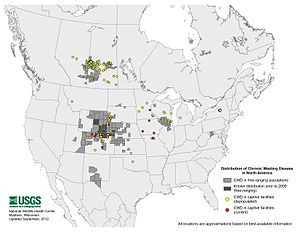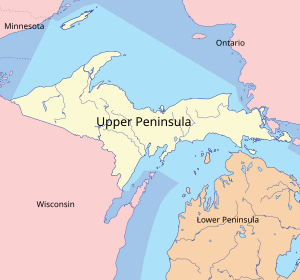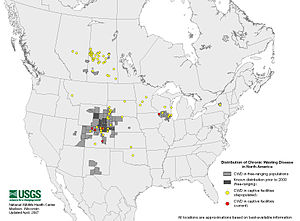 |
| Distribution of Chronic Wasting Disease April, 2007 (Photo credit: Wikipedia) |
DNR wildlife staff will again be in the field during Iowa’s shotgun deer seasons, collecting samples to test for Chronic Wasting Disease (CWD) in Iowa’s wild deer herd. The effort will concentrate on portions of Northeast Iowa near Wisconsin and Illinois as well as in Wapello, Davis, Pottawattamie and Cerro Gordo counties, following positive tests from captive facilities in or near those counties last year.
Many of the samples will be collected during the first half of December, as more than 120,000 hunters take part in Iowa’s shotgun deer seasons and deer harvested during those seasons are major sources of samples. Sampling—which involves removing and testing the brain stem and lymph nodes--has been done on free ranging deer across Iowa for years. Many hunters voluntarily contribute samples of their harvested deer for these testing efforts. Most samples are obtained by wildlife staff, checking with hunters in the field or at home processing points.
DNR has historically focused its sampling efforts heaviest in northeast Iowa, after Wisconsin and Illinois yielded positive cases in recent years. After the positive findings in captive herds in 2012, DNR focused additional testing in those counties identified above. Sampling in northeast Iowa for the 2013-2014 seasons will continue at a slightly lower intensity in order to accommodate the additional testing in Davis, Wapello, Pottawattamie and Cerro Gordo Counties.
Since 2002, more than 47 thousand wild deer in Iowa have been tested, with no positive CWD result in the wild herd detected to date. “We are hopeful CWD has not spread into Iowa’s deer herd. The only way to know this is to continue to collect samples and do the testing. We will work through all hunting seasons, with the peak being the shotgun seasons in December,” said Dr. Dale Garner, Wildlife Bureau Chief.
Iowa DNR’s website provides information about CWD and other information on infectious disease at: http://www.iowadnr.gov/






















